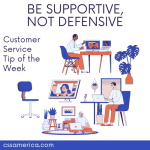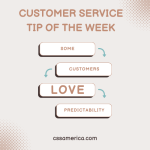You need to do it. You want to do it. Do it.
In life, there are three levels of action. First, you do things because you need to do them. Next, you do things because you want to do them. Lastly, you just do things – they’re a habit.
When most organizations want to get a culture focused on customer service, one way they try to drive that culture home is to put some points of accountability in place. Typically it’s something in a performance evaluation or a customer survey that rates how effectively an employee is providing service. This gets staff to serve in a certain manner because they NEED to in order to get a rating or not get “dinged” on their evaluation.
Many organizations create incentives to drive customer-oriented service behaviors. They do this so that staff will WANT to provide good customer service. Employers also look to hire staff with an orientation that is very customer-focused. They look to hire employees who naturally WANT to help others.
But beyond the need-based and want-based efforts to deliver good service, companies need to strive for the third level of service delivery – it needs to become a habit. It becomes a habit when staff intuitively act to serve. They naturally act in a way that’s focused on and interested in the customer. They are not making mental decisions on whether or not to serve because they need to or want to; they serve because it’s just how they act; it’s a habit.
Think about your habits – good or bad. Where did they come from? They probably came from the role models you had, they came from your practicing something repeatedly, they came from your doing something the same way over a long period of time, they came from doing something simple rather than complex, and they were reinforced from the results you received.
When you’re attempting to foster a culture of service, don’t just convince staff they need to serve or try to make them want to serve. Help them to make it a habit.
Interested in improving your company’s customer service? See more information at: http://www.cssamerica.com/





















